Report: Managing People and Organisational Behaviour at Fonterra
VerifiedAdded on 2023/01/11
|12
|3085
|37
Report
AI Summary
This report provides a detailed analysis of Fonterra's organisational behaviour, examining the application of force field analysis to identify driving and resisting forces during organisational change, particularly in relation to food safety and employee performance. It assesses the principles of Peter Senge's learning organisation, evaluating Fonterra's adherence to concepts like shared vision, systems thinking, mental models, team learning, and personal mastery, and identifies areas for improvement. The report further explores strategies at group, organisational, and individual levels to enhance performance and manage change, incorporating concepts such as the 5W1H model. The report also discusses the ethical considerations in decision-making, using Hodgson's Seven Universal General Principles, and proposes changes to improve work attitudes and mitigate fatigue within the company.
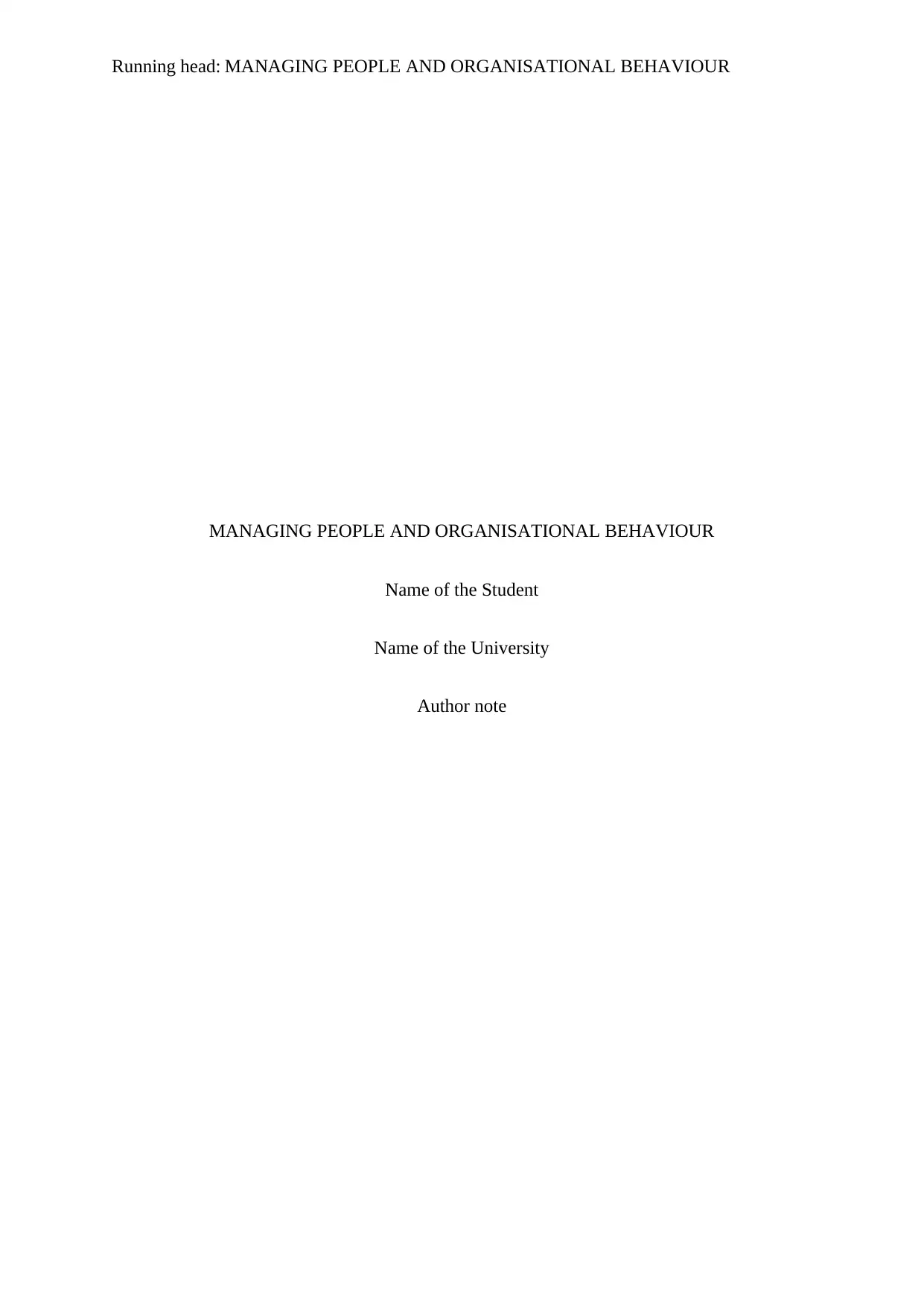
Running head: MANAGING PEOPLE AND ORGANISATIONAL BEHAVIOUR
MANAGING PEOPLE AND ORGANISATIONAL BEHAVIOUR
Name of the Student
Name of the University
Author note
MANAGING PEOPLE AND ORGANISATIONAL BEHAVIOUR
Name of the Student
Name of the University
Author note
Paraphrase This Document
Need a fresh take? Get an instant paraphrase of this document with our AI Paraphraser
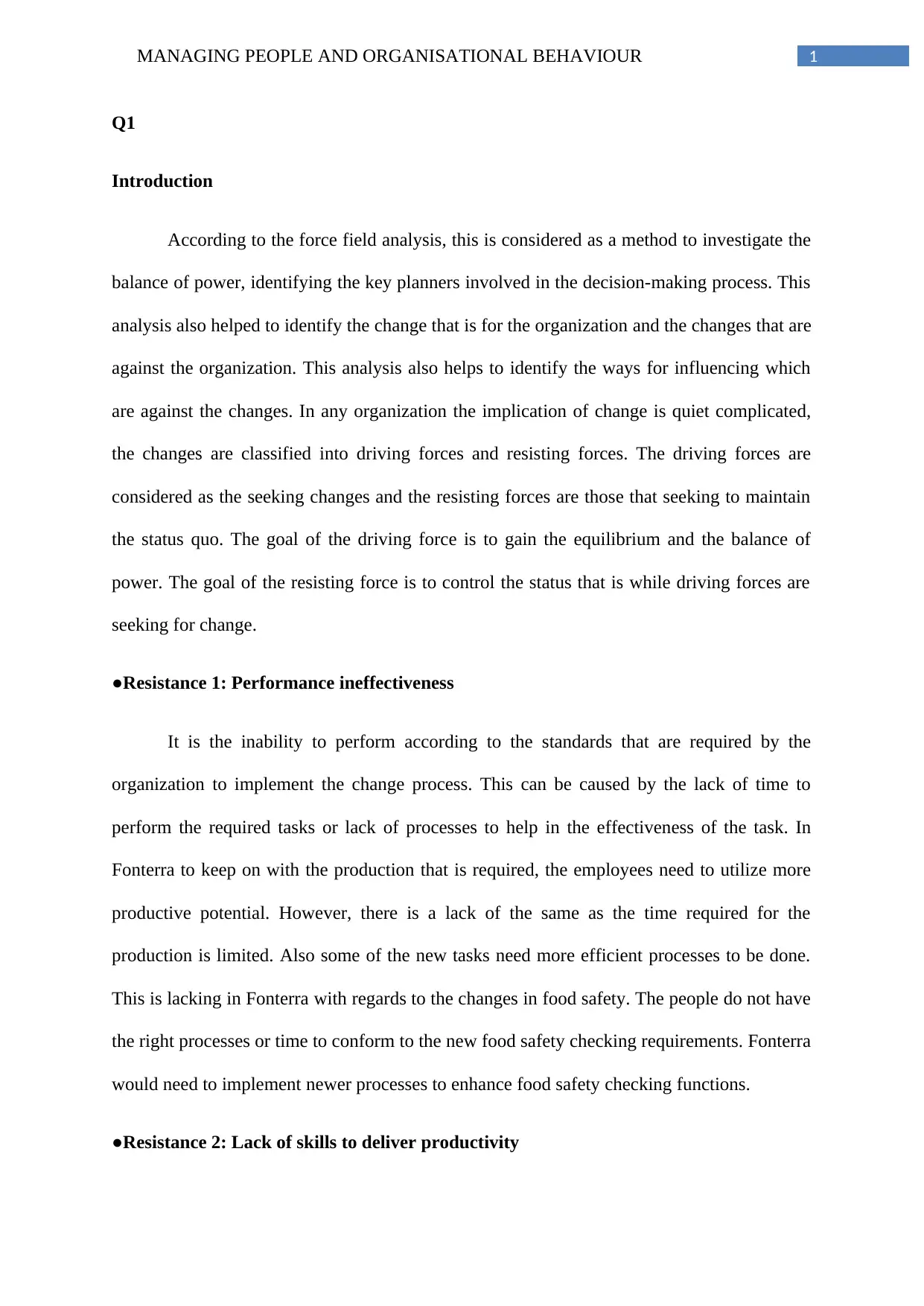
1MANAGING PEOPLE AND ORGANISATIONAL BEHAVIOUR
Q1
Introduction
According to the force field analysis, this is considered as a method to investigate the
balance of power, identifying the key planners involved in the decision-making process. This
analysis also helped to identify the change that is for the organization and the changes that are
against the organization. This analysis also helps to identify the ways for influencing which
are against the changes. In any organization the implication of change is quiet complicated,
the changes are classified into driving forces and resisting forces. The driving forces are
considered as the seeking changes and the resisting forces are those that seeking to maintain
the status quo. The goal of the driving force is to gain the equilibrium and the balance of
power. The goal of the resisting force is to control the status that is while driving forces are
seeking for change.
●Resistance 1: Performance ineffectiveness
It is the inability to perform according to the standards that are required by the
organization to implement the change process. This can be caused by the lack of time to
perform the required tasks or lack of processes to help in the effectiveness of the task. In
Fonterra to keep on with the production that is required, the employees need to utilize more
productive potential. However, there is a lack of the same as the time required for the
production is limited. Also some of the new tasks need more efficient processes to be done.
This is lacking in Fonterra with regards to the changes in food safety. The people do not have
the right processes or time to conform to the new food safety checking requirements. Fonterra
would need to implement newer processes to enhance food safety checking functions.
●Resistance 2: Lack of skills to deliver productivity
Q1
Introduction
According to the force field analysis, this is considered as a method to investigate the
balance of power, identifying the key planners involved in the decision-making process. This
analysis also helped to identify the change that is for the organization and the changes that are
against the organization. This analysis also helps to identify the ways for influencing which
are against the changes. In any organization the implication of change is quiet complicated,
the changes are classified into driving forces and resisting forces. The driving forces are
considered as the seeking changes and the resisting forces are those that seeking to maintain
the status quo. The goal of the driving force is to gain the equilibrium and the balance of
power. The goal of the resisting force is to control the status that is while driving forces are
seeking for change.
●Resistance 1: Performance ineffectiveness
It is the inability to perform according to the standards that are required by the
organization to implement the change process. This can be caused by the lack of time to
perform the required tasks or lack of processes to help in the effectiveness of the task. In
Fonterra to keep on with the production that is required, the employees need to utilize more
productive potential. However, there is a lack of the same as the time required for the
production is limited. Also some of the new tasks need more efficient processes to be done.
This is lacking in Fonterra with regards to the changes in food safety. The people do not have
the right processes or time to conform to the new food safety checking requirements. Fonterra
would need to implement newer processes to enhance food safety checking functions.
●Resistance 2: Lack of skills to deliver productivity
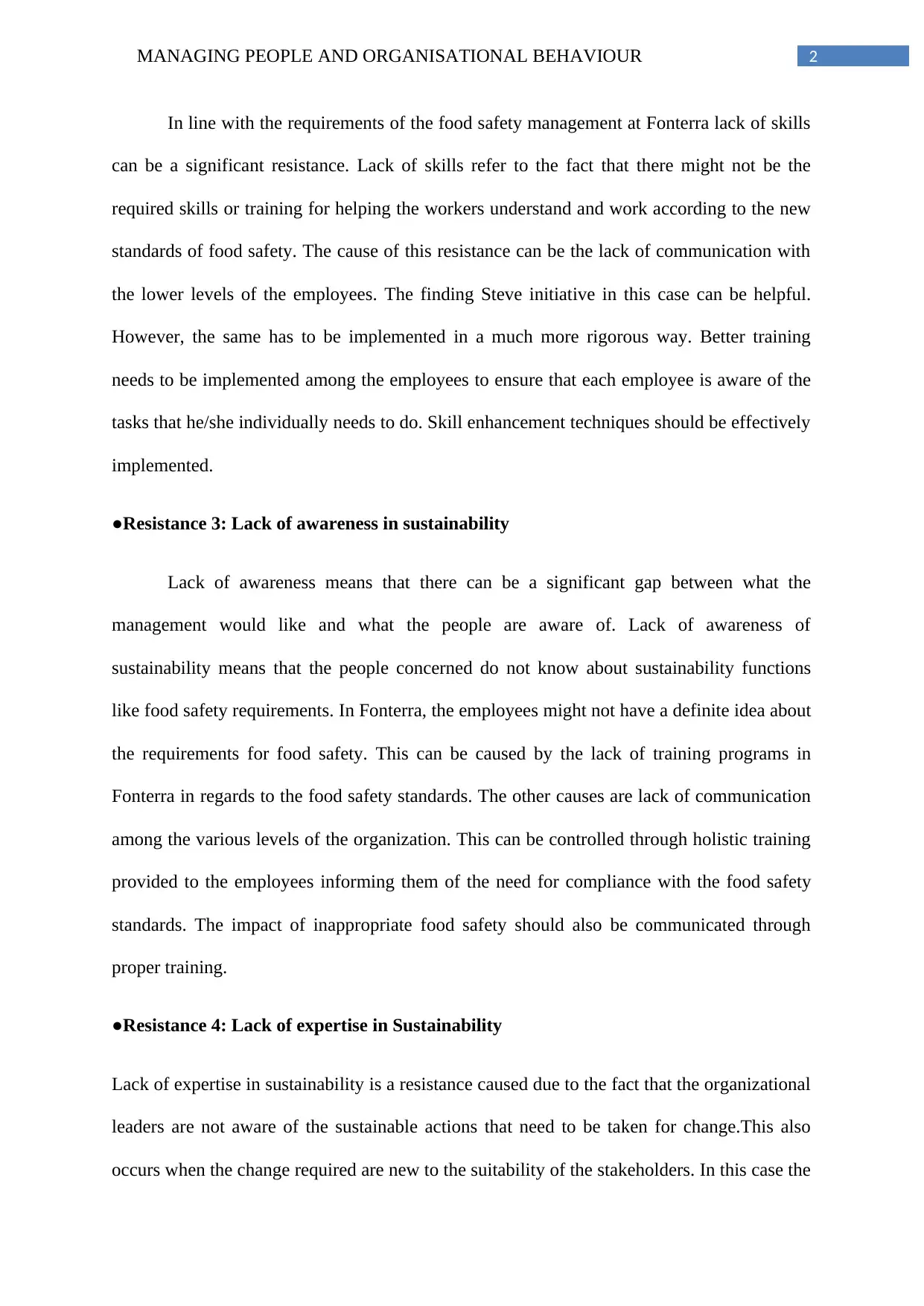
2MANAGING PEOPLE AND ORGANISATIONAL BEHAVIOUR
In line with the requirements of the food safety management at Fonterra lack of skills
can be a significant resistance. Lack of skills refer to the fact that there might not be the
required skills or training for helping the workers understand and work according to the new
standards of food safety. The cause of this resistance can be the lack of communication with
the lower levels of the employees. The finding Steve initiative in this case can be helpful.
However, the same has to be implemented in a much more rigorous way. Better training
needs to be implemented among the employees to ensure that each employee is aware of the
tasks that he/she individually needs to do. Skill enhancement techniques should be effectively
implemented.
●Resistance 3: Lack of awareness in sustainability
Lack of awareness means that there can be a significant gap between what the
management would like and what the people are aware of. Lack of awareness of
sustainability means that the people concerned do not know about sustainability functions
like food safety requirements. In Fonterra, the employees might not have a definite idea about
the requirements for food safety. This can be caused by the lack of training programs in
Fonterra in regards to the food safety standards. The other causes are lack of communication
among the various levels of the organization. This can be controlled through holistic training
provided to the employees informing them of the need for compliance with the food safety
standards. The impact of inappropriate food safety should also be communicated through
proper training.
●Resistance 4: Lack of expertise in Sustainability
Lack of expertise in sustainability is a resistance caused due to the fact that the organizational
leaders are not aware of the sustainable actions that need to be taken for change.This also
occurs when the change required are new to the suitability of the stakeholders. In this case the
In line with the requirements of the food safety management at Fonterra lack of skills
can be a significant resistance. Lack of skills refer to the fact that there might not be the
required skills or training for helping the workers understand and work according to the new
standards of food safety. The cause of this resistance can be the lack of communication with
the lower levels of the employees. The finding Steve initiative in this case can be helpful.
However, the same has to be implemented in a much more rigorous way. Better training
needs to be implemented among the employees to ensure that each employee is aware of the
tasks that he/she individually needs to do. Skill enhancement techniques should be effectively
implemented.
●Resistance 3: Lack of awareness in sustainability
Lack of awareness means that there can be a significant gap between what the
management would like and what the people are aware of. Lack of awareness of
sustainability means that the people concerned do not know about sustainability functions
like food safety requirements. In Fonterra, the employees might not have a definite idea about
the requirements for food safety. This can be caused by the lack of training programs in
Fonterra in regards to the food safety standards. The other causes are lack of communication
among the various levels of the organization. This can be controlled through holistic training
provided to the employees informing them of the need for compliance with the food safety
standards. The impact of inappropriate food safety should also be communicated through
proper training.
●Resistance 4: Lack of expertise in Sustainability
Lack of expertise in sustainability is a resistance caused due to the fact that the organizational
leaders are not aware of the sustainable actions that need to be taken for change.This also
occurs when the change required are new to the suitability of the stakeholders. In this case the
⊘ This is a preview!⊘
Do you want full access?
Subscribe today to unlock all pages.

Trusted by 1+ million students worldwide
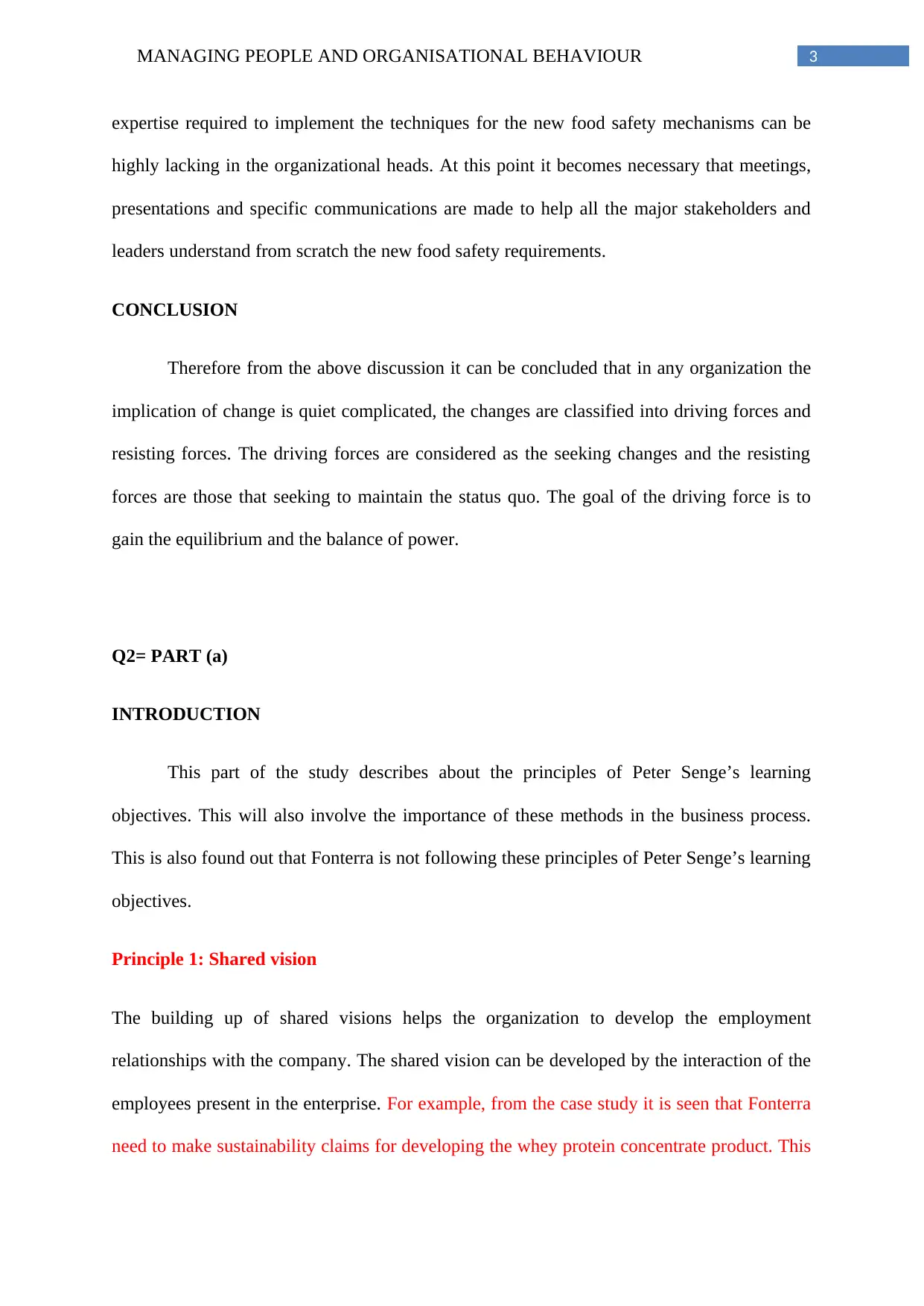
3MANAGING PEOPLE AND ORGANISATIONAL BEHAVIOUR
expertise required to implement the techniques for the new food safety mechanisms can be
highly lacking in the organizational heads. At this point it becomes necessary that meetings,
presentations and specific communications are made to help all the major stakeholders and
leaders understand from scratch the new food safety requirements.
CONCLUSION
Therefore from the above discussion it can be concluded that in any organization the
implication of change is quiet complicated, the changes are classified into driving forces and
resisting forces. The driving forces are considered as the seeking changes and the resisting
forces are those that seeking to maintain the status quo. The goal of the driving force is to
gain the equilibrium and the balance of power.
Q2= PART (a)
INTRODUCTION
This part of the study describes about the principles of Peter Senge’s learning
objectives. This will also involve the importance of these methods in the business process.
This is also found out that Fonterra is not following these principles of Peter Senge’s learning
objectives.
Principle 1: Shared vision
The building up of shared visions helps the organization to develop the employment
relationships with the company. The shared vision can be developed by the interaction of the
employees present in the enterprise. For example, from the case study it is seen that Fonterra
need to make sustainability claims for developing the whey protein concentrate product. This
expertise required to implement the techniques for the new food safety mechanisms can be
highly lacking in the organizational heads. At this point it becomes necessary that meetings,
presentations and specific communications are made to help all the major stakeholders and
leaders understand from scratch the new food safety requirements.
CONCLUSION
Therefore from the above discussion it can be concluded that in any organization the
implication of change is quiet complicated, the changes are classified into driving forces and
resisting forces. The driving forces are considered as the seeking changes and the resisting
forces are those that seeking to maintain the status quo. The goal of the driving force is to
gain the equilibrium and the balance of power.
Q2= PART (a)
INTRODUCTION
This part of the study describes about the principles of Peter Senge’s learning
objectives. This will also involve the importance of these methods in the business process.
This is also found out that Fonterra is not following these principles of Peter Senge’s learning
objectives.
Principle 1: Shared vision
The building up of shared visions helps the organization to develop the employment
relationships with the company. The shared vision can be developed by the interaction of the
employees present in the enterprise. For example, from the case study it is seen that Fonterra
need to make sustainability claims for developing the whey protein concentrate product. This
Paraphrase This Document
Need a fresh take? Get an instant paraphrase of this document with our AI Paraphraser
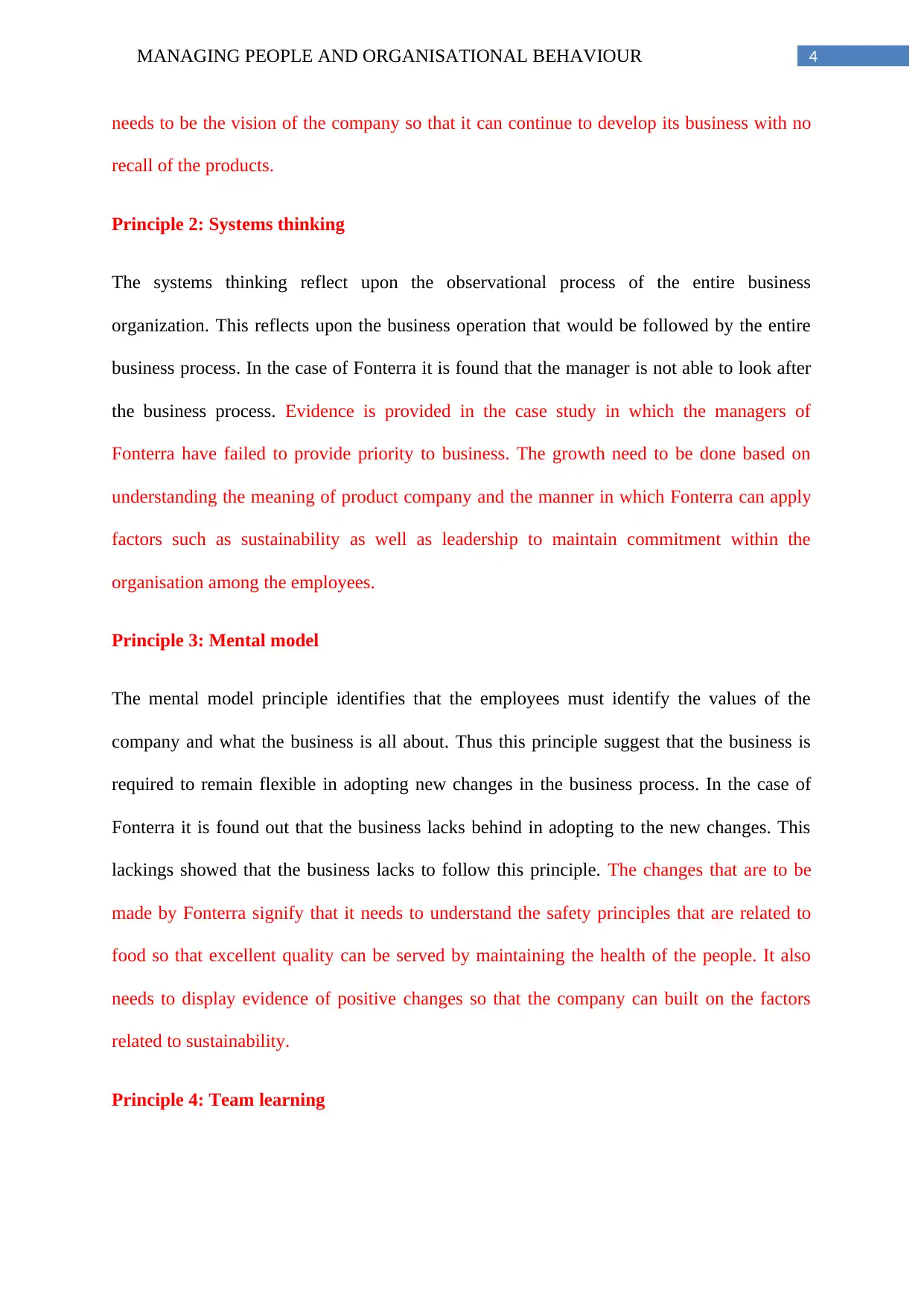
4MANAGING PEOPLE AND ORGANISATIONAL BEHAVIOUR
needs to be the vision of the company so that it can continue to develop its business with no
recall of the products.
Principle 2: Systems thinking
The systems thinking reflect upon the observational process of the entire business
organization. This reflects upon the business operation that would be followed by the entire
business process. In the case of Fonterra it is found that the manager is not able to look after
the business process. Evidence is provided in the case study in which the managers of
Fonterra have failed to provide priority to business. The growth need to be done based on
understanding the meaning of product company and the manner in which Fonterra can apply
factors such as sustainability as well as leadership to maintain commitment within the
organisation among the employees.
Principle 3: Mental model
The mental model principle identifies that the employees must identify the values of the
company and what the business is all about. Thus this principle suggest that the business is
required to remain flexible in adopting new changes in the business process. In the case of
Fonterra it is found out that the business lacks behind in adopting to the new changes. This
lackings showed that the business lacks to follow this principle. The changes that are to be
made by Fonterra signify that it needs to understand the safety principles that are related to
food so that excellent quality can be served by maintaining the health of the people. It also
needs to display evidence of positive changes so that the company can built on the factors
related to sustainability.
Principle 4: Team learning
needs to be the vision of the company so that it can continue to develop its business with no
recall of the products.
Principle 2: Systems thinking
The systems thinking reflect upon the observational process of the entire business
organization. This reflects upon the business operation that would be followed by the entire
business process. In the case of Fonterra it is found that the manager is not able to look after
the business process. Evidence is provided in the case study in which the managers of
Fonterra have failed to provide priority to business. The growth need to be done based on
understanding the meaning of product company and the manner in which Fonterra can apply
factors such as sustainability as well as leadership to maintain commitment within the
organisation among the employees.
Principle 3: Mental model
The mental model principle identifies that the employees must identify the values of the
company and what the business is all about. Thus this principle suggest that the business is
required to remain flexible in adopting new changes in the business process. In the case of
Fonterra it is found out that the business lacks behind in adopting to the new changes. This
lackings showed that the business lacks to follow this principle. The changes that are to be
made by Fonterra signify that it needs to understand the safety principles that are related to
food so that excellent quality can be served by maintaining the health of the people. It also
needs to display evidence of positive changes so that the company can built on the factors
related to sustainability.
Principle 4: Team learning
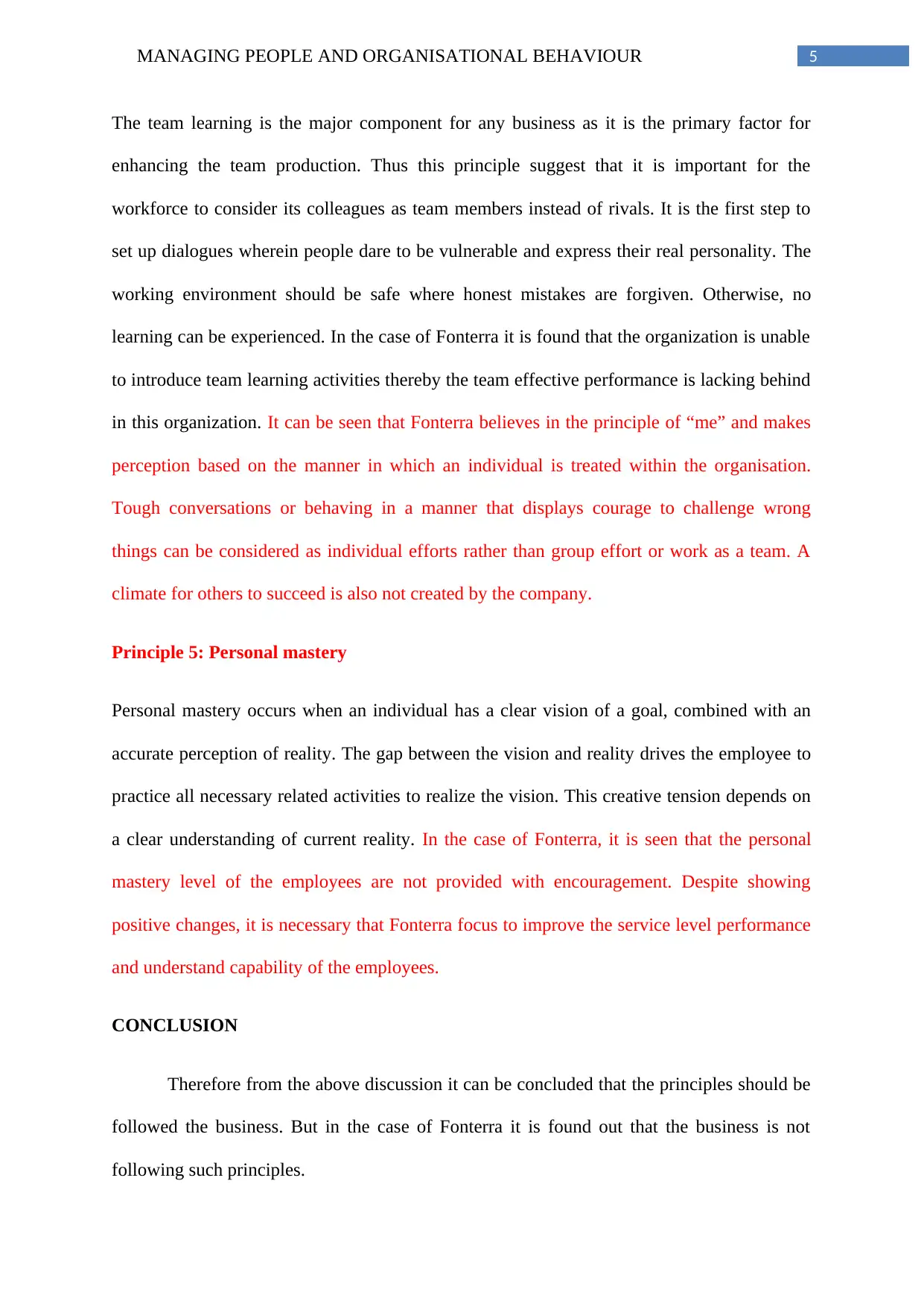
5MANAGING PEOPLE AND ORGANISATIONAL BEHAVIOUR
The team learning is the major component for any business as it is the primary factor for
enhancing the team production. Thus this principle suggest that it is important for the
workforce to consider its colleagues as team members instead of rivals. It is the first step to
set up dialogues wherein people dare to be vulnerable and express their real personality. The
working environment should be safe where honest mistakes are forgiven. Otherwise, no
learning can be experienced. In the case of Fonterra it is found that the organization is unable
to introduce team learning activities thereby the team effective performance is lacking behind
in this organization. It can be seen that Fonterra believes in the principle of “me” and makes
perception based on the manner in which an individual is treated within the organisation.
Tough conversations or behaving in a manner that displays courage to challenge wrong
things can be considered as individual efforts rather than group effort or work as a team. A
climate for others to succeed is also not created by the company.
Principle 5: Personal mastery
Personal mastery occurs when an individual has a clear vision of a goal, combined with an
accurate perception of reality. The gap between the vision and reality drives the employee to
practice all necessary related activities to realize the vision. This creative tension depends on
a clear understanding of current reality. In the case of Fonterra, it is seen that the personal
mastery level of the employees are not provided with encouragement. Despite showing
positive changes, it is necessary that Fonterra focus to improve the service level performance
and understand capability of the employees.
CONCLUSION
Therefore from the above discussion it can be concluded that the principles should be
followed the business. But in the case of Fonterra it is found out that the business is not
following such principles.
The team learning is the major component for any business as it is the primary factor for
enhancing the team production. Thus this principle suggest that it is important for the
workforce to consider its colleagues as team members instead of rivals. It is the first step to
set up dialogues wherein people dare to be vulnerable and express their real personality. The
working environment should be safe where honest mistakes are forgiven. Otherwise, no
learning can be experienced. In the case of Fonterra it is found that the organization is unable
to introduce team learning activities thereby the team effective performance is lacking behind
in this organization. It can be seen that Fonterra believes in the principle of “me” and makes
perception based on the manner in which an individual is treated within the organisation.
Tough conversations or behaving in a manner that displays courage to challenge wrong
things can be considered as individual efforts rather than group effort or work as a team. A
climate for others to succeed is also not created by the company.
Principle 5: Personal mastery
Personal mastery occurs when an individual has a clear vision of a goal, combined with an
accurate perception of reality. The gap between the vision and reality drives the employee to
practice all necessary related activities to realize the vision. This creative tension depends on
a clear understanding of current reality. In the case of Fonterra, it is seen that the personal
mastery level of the employees are not provided with encouragement. Despite showing
positive changes, it is necessary that Fonterra focus to improve the service level performance
and understand capability of the employees.
CONCLUSION
Therefore from the above discussion it can be concluded that the principles should be
followed the business. But in the case of Fonterra it is found out that the business is not
following such principles.
⊘ This is a preview!⊘
Do you want full access?
Subscribe today to unlock all pages.

Trusted by 1+ million students worldwide
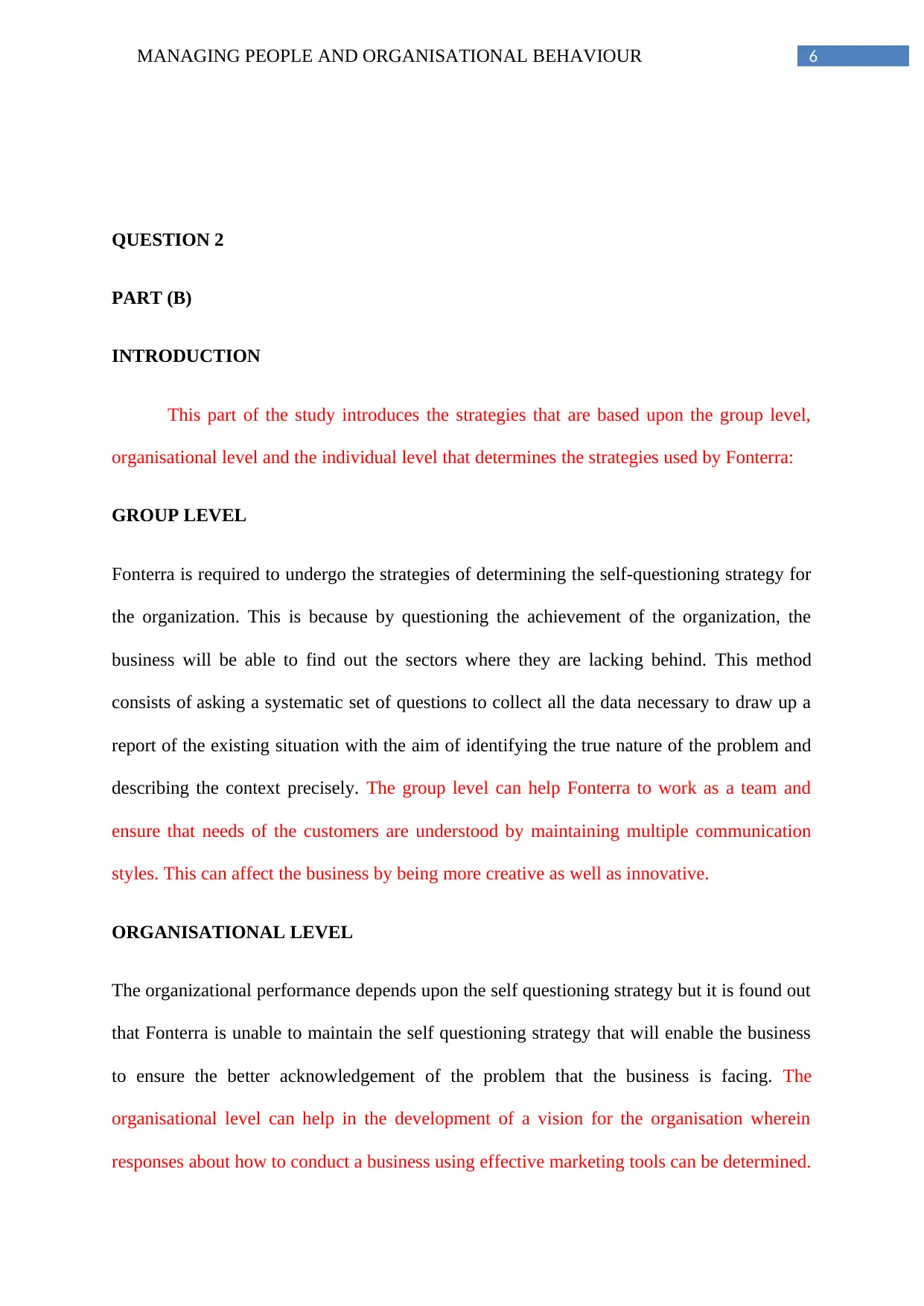
6MANAGING PEOPLE AND ORGANISATIONAL BEHAVIOUR
QUESTION 2
PART (B)
INTRODUCTION
This part of the study introduces the strategies that are based upon the group level,
organisational level and the individual level that determines the strategies used by Fonterra:
GROUP LEVEL
Fonterra is required to undergo the strategies of determining the self-questioning strategy for
the organization. This is because by questioning the achievement of the organization, the
business will be able to find out the sectors where they are lacking behind. This method
consists of asking a systematic set of questions to collect all the data necessary to draw up a
report of the existing situation with the aim of identifying the true nature of the problem and
describing the context precisely. The group level can help Fonterra to work as a team and
ensure that needs of the customers are understood by maintaining multiple communication
styles. This can affect the business by being more creative as well as innovative.
ORGANISATIONAL LEVEL
The organizational performance depends upon the self questioning strategy but it is found out
that Fonterra is unable to maintain the self questioning strategy that will enable the business
to ensure the better acknowledgement of the problem that the business is facing. The
organisational level can help in the development of a vision for the organisation wherein
responses about how to conduct a business using effective marketing tools can be determined.
QUESTION 2
PART (B)
INTRODUCTION
This part of the study introduces the strategies that are based upon the group level,
organisational level and the individual level that determines the strategies used by Fonterra:
GROUP LEVEL
Fonterra is required to undergo the strategies of determining the self-questioning strategy for
the organization. This is because by questioning the achievement of the organization, the
business will be able to find out the sectors where they are lacking behind. This method
consists of asking a systematic set of questions to collect all the data necessary to draw up a
report of the existing situation with the aim of identifying the true nature of the problem and
describing the context precisely. The group level can help Fonterra to work as a team and
ensure that needs of the customers are understood by maintaining multiple communication
styles. This can affect the business by being more creative as well as innovative.
ORGANISATIONAL LEVEL
The organizational performance depends upon the self questioning strategy but it is found out
that Fonterra is unable to maintain the self questioning strategy that will enable the business
to ensure the better acknowledgement of the problem that the business is facing. The
organisational level can help in the development of a vision for the organisation wherein
responses about how to conduct a business using effective marketing tools can be determined.
Paraphrase This Document
Need a fresh take? Get an instant paraphrase of this document with our AI Paraphraser
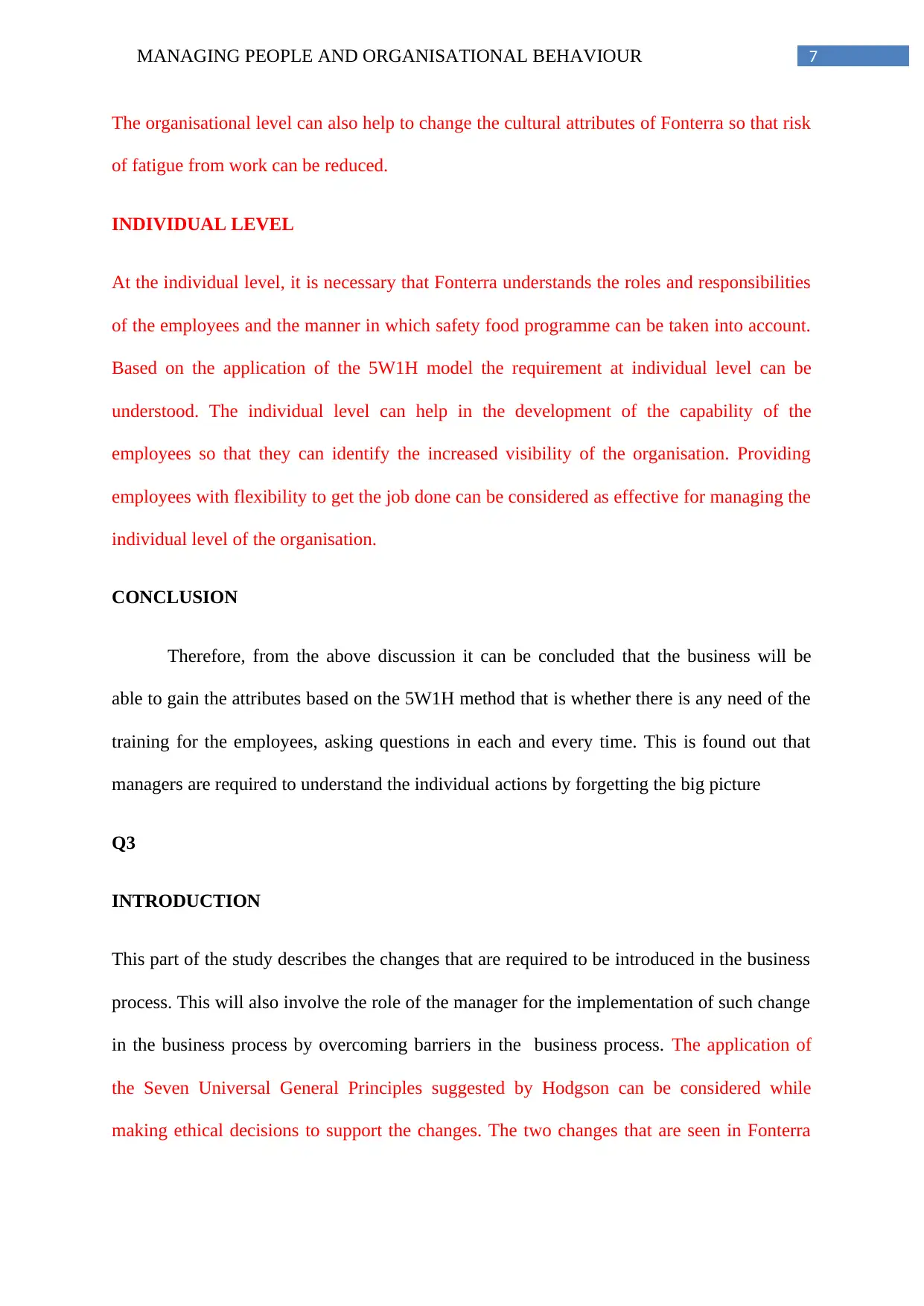
7MANAGING PEOPLE AND ORGANISATIONAL BEHAVIOUR
The organisational level can also help to change the cultural attributes of Fonterra so that risk
of fatigue from work can be reduced.
INDIVIDUAL LEVEL
At the individual level, it is necessary that Fonterra understands the roles and responsibilities
of the employees and the manner in which safety food programme can be taken into account.
Based on the application of the 5W1H model the requirement at individual level can be
understood. The individual level can help in the development of the capability of the
employees so that they can identify the increased visibility of the organisation. Providing
employees with flexibility to get the job done can be considered as effective for managing the
individual level of the organisation.
CONCLUSION
Therefore, from the above discussion it can be concluded that the business will be
able to gain the attributes based on the 5W1H method that is whether there is any need of the
training for the employees, asking questions in each and every time. This is found out that
managers are required to understand the individual actions by forgetting the big picture
Q3
INTRODUCTION
This part of the study describes the changes that are required to be introduced in the business
process. This will also involve the role of the manager for the implementation of such change
in the business process by overcoming barriers in the business process. The application of
the Seven Universal General Principles suggested by Hodgson can be considered while
making ethical decisions to support the changes. The two changes that are seen in Fonterra
The organisational level can also help to change the cultural attributes of Fonterra so that risk
of fatigue from work can be reduced.
INDIVIDUAL LEVEL
At the individual level, it is necessary that Fonterra understands the roles and responsibilities
of the employees and the manner in which safety food programme can be taken into account.
Based on the application of the 5W1H model the requirement at individual level can be
understood. The individual level can help in the development of the capability of the
employees so that they can identify the increased visibility of the organisation. Providing
employees with flexibility to get the job done can be considered as effective for managing the
individual level of the organisation.
CONCLUSION
Therefore, from the above discussion it can be concluded that the business will be
able to gain the attributes based on the 5W1H method that is whether there is any need of the
training for the employees, asking questions in each and every time. This is found out that
managers are required to understand the individual actions by forgetting the big picture
Q3
INTRODUCTION
This part of the study describes the changes that are required to be introduced in the business
process. This will also involve the role of the manager for the implementation of such change
in the business process by overcoming barriers in the business process. The application of
the Seven Universal General Principles suggested by Hodgson can be considered while
making ethical decisions to support the changes. The two changes that are seen in Fonterra
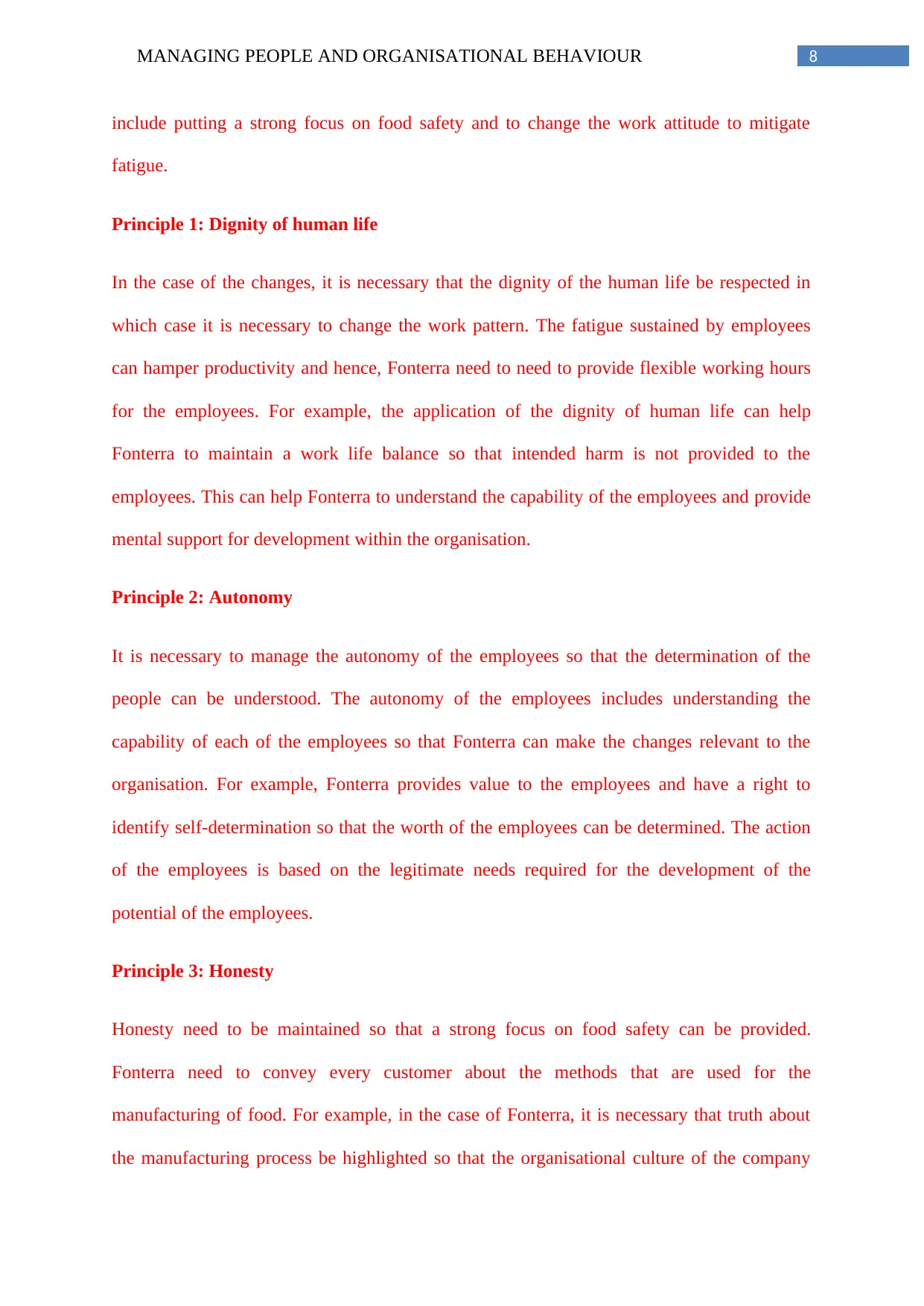
8MANAGING PEOPLE AND ORGANISATIONAL BEHAVIOUR
include putting a strong focus on food safety and to change the work attitude to mitigate
fatigue.
Principle 1: Dignity of human life
In the case of the changes, it is necessary that the dignity of the human life be respected in
which case it is necessary to change the work pattern. The fatigue sustained by employees
can hamper productivity and hence, Fonterra need to need to provide flexible working hours
for the employees. For example, the application of the dignity of human life can help
Fonterra to maintain a work life balance so that intended harm is not provided to the
employees. This can help Fonterra to understand the capability of the employees and provide
mental support for development within the organisation.
Principle 2: Autonomy
It is necessary to manage the autonomy of the employees so that the determination of the
people can be understood. The autonomy of the employees includes understanding the
capability of each of the employees so that Fonterra can make the changes relevant to the
organisation. For example, Fonterra provides value to the employees and have a right to
identify self-determination so that the worth of the employees can be determined. The action
of the employees is based on the legitimate needs required for the development of the
potential of the employees.
Principle 3: Honesty
Honesty need to be maintained so that a strong focus on food safety can be provided.
Fonterra need to convey every customer about the methods that are used for the
manufacturing of food. For example, in the case of Fonterra, it is necessary that truth about
the manufacturing process be highlighted so that the organisational culture of the company
include putting a strong focus on food safety and to change the work attitude to mitigate
fatigue.
Principle 1: Dignity of human life
In the case of the changes, it is necessary that the dignity of the human life be respected in
which case it is necessary to change the work pattern. The fatigue sustained by employees
can hamper productivity and hence, Fonterra need to need to provide flexible working hours
for the employees. For example, the application of the dignity of human life can help
Fonterra to maintain a work life balance so that intended harm is not provided to the
employees. This can help Fonterra to understand the capability of the employees and provide
mental support for development within the organisation.
Principle 2: Autonomy
It is necessary to manage the autonomy of the employees so that the determination of the
people can be understood. The autonomy of the employees includes understanding the
capability of each of the employees so that Fonterra can make the changes relevant to the
organisation. For example, Fonterra provides value to the employees and have a right to
identify self-determination so that the worth of the employees can be determined. The action
of the employees is based on the legitimate needs required for the development of the
potential of the employees.
Principle 3: Honesty
Honesty need to be maintained so that a strong focus on food safety can be provided.
Fonterra need to convey every customer about the methods that are used for the
manufacturing of food. For example, in the case of Fonterra, it is necessary that truth about
the manufacturing process be highlighted so that the organisational culture of the company
⊘ This is a preview!⊘
Do you want full access?
Subscribe today to unlock all pages.

Trusted by 1+ million students worldwide
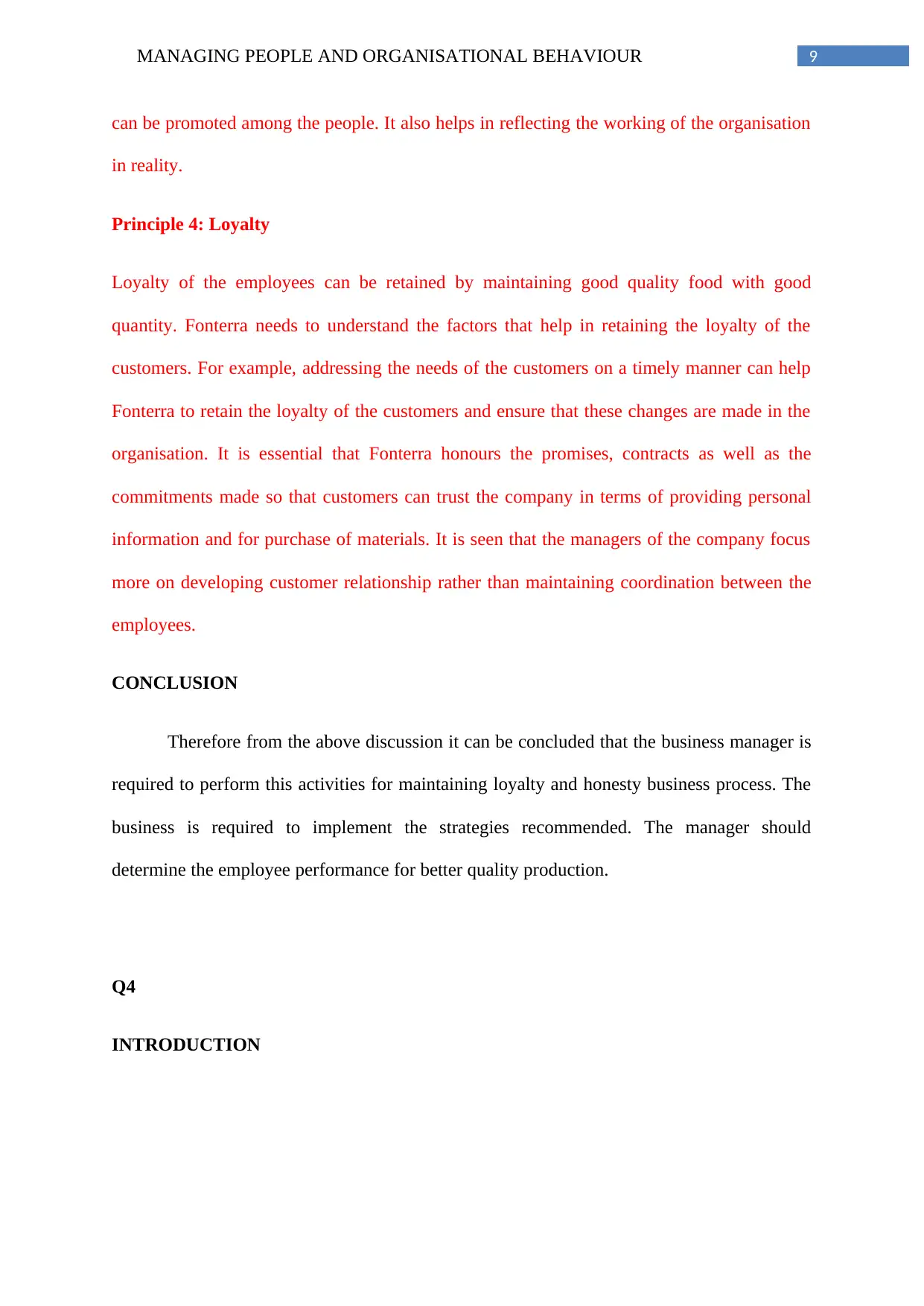
9MANAGING PEOPLE AND ORGANISATIONAL BEHAVIOUR
can be promoted among the people. It also helps in reflecting the working of the organisation
in reality.
Principle 4: Loyalty
Loyalty of the employees can be retained by maintaining good quality food with good
quantity. Fonterra needs to understand the factors that help in retaining the loyalty of the
customers. For example, addressing the needs of the customers on a timely manner can help
Fonterra to retain the loyalty of the customers and ensure that these changes are made in the
organisation. It is essential that Fonterra honours the promises, contracts as well as the
commitments made so that customers can trust the company in terms of providing personal
information and for purchase of materials. It is seen that the managers of the company focus
more on developing customer relationship rather than maintaining coordination between the
employees.
CONCLUSION
Therefore from the above discussion it can be concluded that the business manager is
required to perform this activities for maintaining loyalty and honesty business process. The
business is required to implement the strategies recommended. The manager should
determine the employee performance for better quality production.
Q4
INTRODUCTION
can be promoted among the people. It also helps in reflecting the working of the organisation
in reality.
Principle 4: Loyalty
Loyalty of the employees can be retained by maintaining good quality food with good
quantity. Fonterra needs to understand the factors that help in retaining the loyalty of the
customers. For example, addressing the needs of the customers on a timely manner can help
Fonterra to retain the loyalty of the customers and ensure that these changes are made in the
organisation. It is essential that Fonterra honours the promises, contracts as well as the
commitments made so that customers can trust the company in terms of providing personal
information and for purchase of materials. It is seen that the managers of the company focus
more on developing customer relationship rather than maintaining coordination between the
employees.
CONCLUSION
Therefore from the above discussion it can be concluded that the business manager is
required to perform this activities for maintaining loyalty and honesty business process. The
business is required to implement the strategies recommended. The manager should
determine the employee performance for better quality production.
Q4
INTRODUCTION
Paraphrase This Document
Need a fresh take? Get an instant paraphrase of this document with our AI Paraphraser
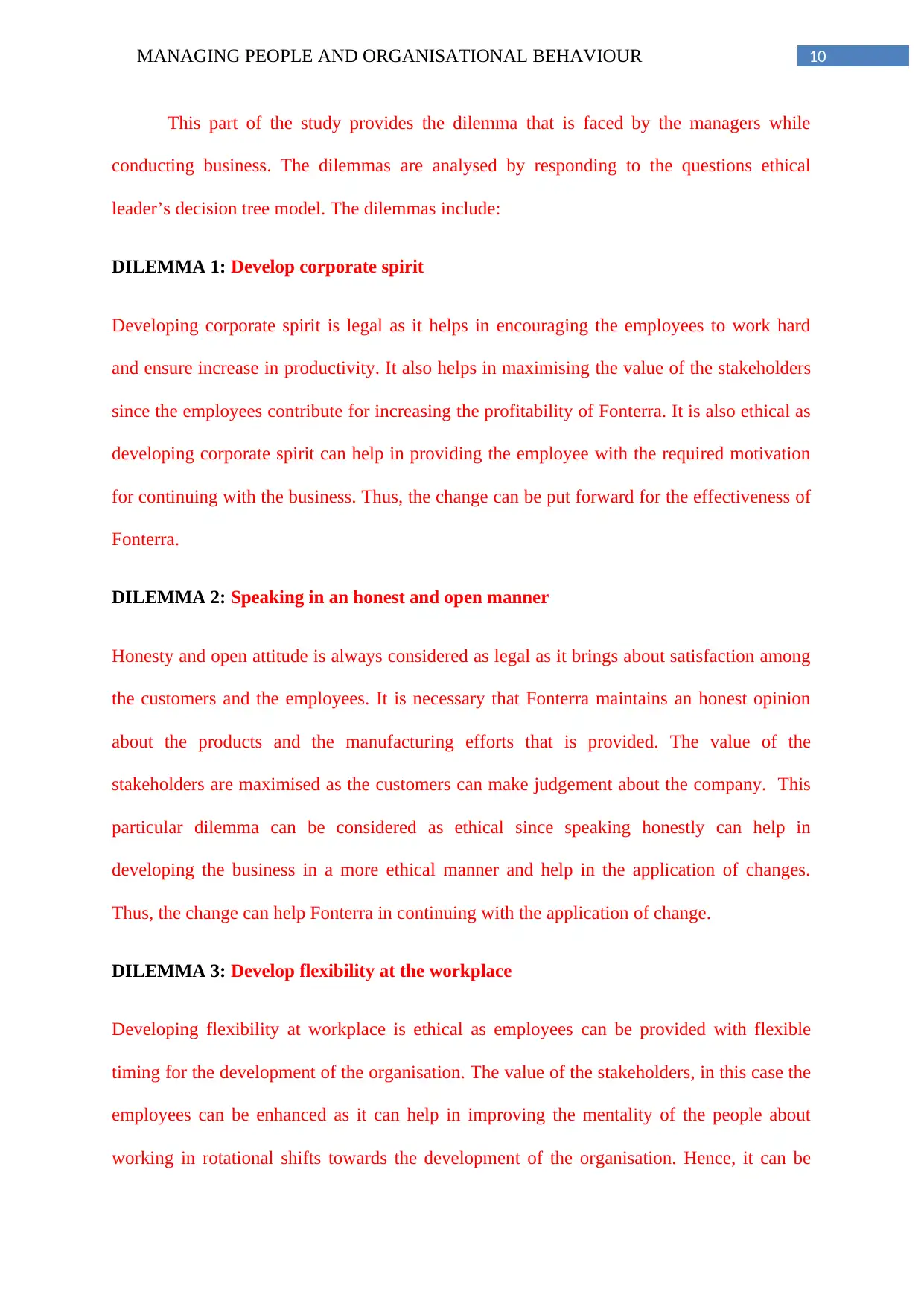
10MANAGING PEOPLE AND ORGANISATIONAL BEHAVIOUR
This part of the study provides the dilemma that is faced by the managers while
conducting business. The dilemmas are analysed by responding to the questions ethical
leader’s decision tree model. The dilemmas include:
DILEMMA 1: Develop corporate spirit
Developing corporate spirit is legal as it helps in encouraging the employees to work hard
and ensure increase in productivity. It also helps in maximising the value of the stakeholders
since the employees contribute for increasing the profitability of Fonterra. It is also ethical as
developing corporate spirit can help in providing the employee with the required motivation
for continuing with the business. Thus, the change can be put forward for the effectiveness of
Fonterra.
DILEMMA 2: Speaking in an honest and open manner
Honesty and open attitude is always considered as legal as it brings about satisfaction among
the customers and the employees. It is necessary that Fonterra maintains an honest opinion
about the products and the manufacturing efforts that is provided. The value of the
stakeholders are maximised as the customers can make judgement about the company. This
particular dilemma can be considered as ethical since speaking honestly can help in
developing the business in a more ethical manner and help in the application of changes.
Thus, the change can help Fonterra in continuing with the application of change.
DILEMMA 3: Develop flexibility at the workplace
Developing flexibility at workplace is ethical as employees can be provided with flexible
timing for the development of the organisation. The value of the stakeholders, in this case the
employees can be enhanced as it can help in improving the mentality of the people about
working in rotational shifts towards the development of the organisation. Hence, it can be
This part of the study provides the dilemma that is faced by the managers while
conducting business. The dilemmas are analysed by responding to the questions ethical
leader’s decision tree model. The dilemmas include:
DILEMMA 1: Develop corporate spirit
Developing corporate spirit is legal as it helps in encouraging the employees to work hard
and ensure increase in productivity. It also helps in maximising the value of the stakeholders
since the employees contribute for increasing the profitability of Fonterra. It is also ethical as
developing corporate spirit can help in providing the employee with the required motivation
for continuing with the business. Thus, the change can be put forward for the effectiveness of
Fonterra.
DILEMMA 2: Speaking in an honest and open manner
Honesty and open attitude is always considered as legal as it brings about satisfaction among
the customers and the employees. It is necessary that Fonterra maintains an honest opinion
about the products and the manufacturing efforts that is provided. The value of the
stakeholders are maximised as the customers can make judgement about the company. This
particular dilemma can be considered as ethical since speaking honestly can help in
developing the business in a more ethical manner and help in the application of changes.
Thus, the change can help Fonterra in continuing with the application of change.
DILEMMA 3: Develop flexibility at the workplace
Developing flexibility at workplace is ethical as employees can be provided with flexible
timing for the development of the organisation. The value of the stakeholders, in this case the
employees can be enhanced as it can help in improving the mentality of the people about
working in rotational shifts towards the development of the organisation. Hence, it can be
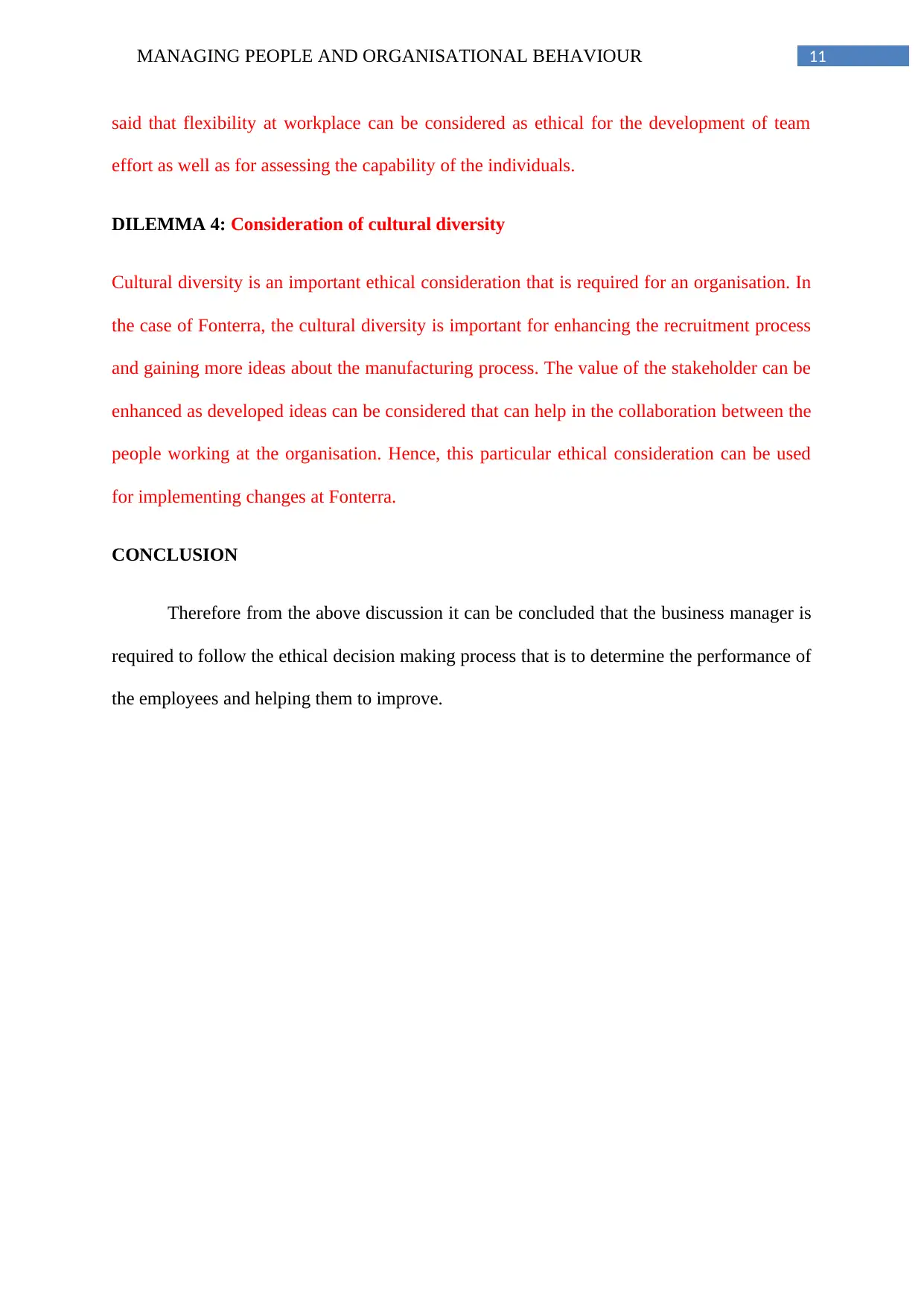
11MANAGING PEOPLE AND ORGANISATIONAL BEHAVIOUR
said that flexibility at workplace can be considered as ethical for the development of team
effort as well as for assessing the capability of the individuals.
DILEMMA 4: Consideration of cultural diversity
Cultural diversity is an important ethical consideration that is required for an organisation. In
the case of Fonterra, the cultural diversity is important for enhancing the recruitment process
and gaining more ideas about the manufacturing process. The value of the stakeholder can be
enhanced as developed ideas can be considered that can help in the collaboration between the
people working at the organisation. Hence, this particular ethical consideration can be used
for implementing changes at Fonterra.
CONCLUSION
Therefore from the above discussion it can be concluded that the business manager is
required to follow the ethical decision making process that is to determine the performance of
the employees and helping them to improve.
said that flexibility at workplace can be considered as ethical for the development of team
effort as well as for assessing the capability of the individuals.
DILEMMA 4: Consideration of cultural diversity
Cultural diversity is an important ethical consideration that is required for an organisation. In
the case of Fonterra, the cultural diversity is important for enhancing the recruitment process
and gaining more ideas about the manufacturing process. The value of the stakeholder can be
enhanced as developed ideas can be considered that can help in the collaboration between the
people working at the organisation. Hence, this particular ethical consideration can be used
for implementing changes at Fonterra.
CONCLUSION
Therefore from the above discussion it can be concluded that the business manager is
required to follow the ethical decision making process that is to determine the performance of
the employees and helping them to improve.
⊘ This is a preview!⊘
Do you want full access?
Subscribe today to unlock all pages.

Trusted by 1+ million students worldwide
1 out of 12
Related Documents
Your All-in-One AI-Powered Toolkit for Academic Success.
+13062052269
info@desklib.com
Available 24*7 on WhatsApp / Email
![[object Object]](/_next/static/media/star-bottom.7253800d.svg)
Unlock your academic potential
Copyright © 2020–2025 A2Z Services. All Rights Reserved. Developed and managed by ZUCOL.





